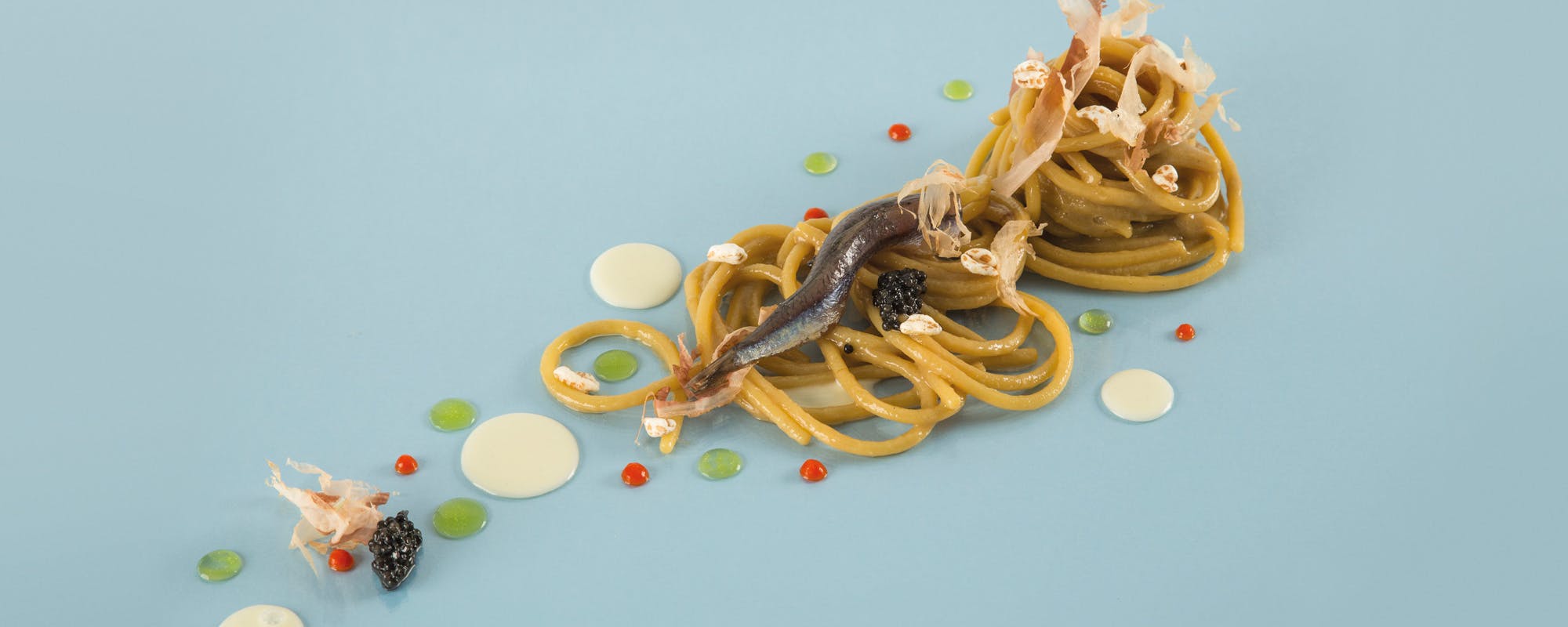of the blue sea and fish
Recommended in any diet, delicious, plentiful, rich in amazing properties, pesce azzurro oily fish have long been stars on our tables. But can they perform as well in support of a circular kitchen economy? We would have to say yes, based on the dishes prepared for us by several of Versilia’s top chefs.
Words Irene Arquint - Photography Gabriele Ancillotti
Anchovy, bonito, garrick, mackerel, dorado, sardine, scabbardfish: the varieties of pesce azzurro oily fish are countless and all are beneficial to health. Cloaked in dark blue to confound predators looking down, their undersides pale to fool others looking up, these treasures of Omega3 shine as brightly as the surface of the sea that bathes Versilia. We asked seven chefs to tell us about the lasting love story between Versilia’s tables and the fish of its emblematic waters. These are the routes they charted, each according to their personal style, in the name of circularity and with great respect for this precious raw material.
Sgombro marinato alle tre salse
At Enoteca Giulia, where Spain and Versilia meet in the kitchen, mackerel fillets marinated in salt, sugar, lemon, and Spanish pimenton are served with a pleasantly garlicky Andalusian (ajilimójili) sauce, another from the Tarragon region (romesco) in which nuts exalt the flavor of the fish, and a palate-cleansing cucumber sauce, accompanied by a Napa cabbage and piquillo pepper salad with toasted almonds.
Spaghettone alle alici
A journey to more or less far-off lands for Valentino Cassanelli of Lux Lucis as well. He dressed up very Italian thick spaghetti with anchovies, umeboshi, caviar, and burrata water after a cathartic detour through Venice’s lagoon (to learn the rituals of making brodetto fish stock), to Japan (for the umeboshi and katsuobushi), and the Caspian Sea (the caviar) before returning to Versilia’s shores – and borrowing puffed farro from inland Garfagnana.
Palamita al barbecue in olio di cottura
Michele Mascia of Bagni di Villa Grey transformed the roe of a bonito into a bottarga smoked with wood from the olive tree so typical of the Versilian landscape. He used the liver for a foie gras seasoned with the aromas of the Mediterranean maquis and foamed it onto a salted caramel macaron. The flesh, instead, made its way to the barbecue, where a variety of sauces (beer and honey, Worcestershire, soy) were assigned the tasks of exalting both flavor and succulence. And the fin, served as one would a steak, closed a virtuous circle that included various cooking methods.
Sugarello su purea di asparagi e petali di rosa
A fin – this time one belonging to a horse mackerel – also appeared in the dish presented by Chef Nicola Mannella of the Barca. With the head and bones, and shavings from asparagus picked on the slopes of Camaiore, he created a stock with the fragrance of roses, which he used to marinate the fish steaks before oven-baking them in an aromatic breading. The combo of local wild asparagus with fish caught with hook and line off the rocks at Viareggio also inspired the chef’s bavette pasta, cooked risotto-style in the same stock and completed with a tartare of the same fish.
Lampuga caramellata con patata fondente
The oily fishes require great care during cooking, since they tend to dry out. In this next entry, the dorado chosen by Il Centauro was pampered with a sauce (a collagen-rich reduction of a stock made with the fish’s bones and flavored with soy sauce to add sweetness). The dorado is an excellent baking fish, with a generous but not overly thick fillet that permits limiting oven time to a quick in-and-out.
Pesce sciabola in crosta su salsa al cocco
Alessandro Lucchinelli of The Village, instead, chose the decidedly smaller scabbardfish for its delicate flesh. Well aware of its quality, the chef opted for a strategy of minimum intervention, oven-browning the fillet in a panko and hazelnut crust and serving it with a coconut sauce and paired with a lightly blanched and as lightly sautéed trio of peas, artichokes, and asparagus.
Sarde a beccafico
The traditions of the south of Italy surfaced in the revisitation of sarde a beccafico served up at Alex: a personal, modern interpretation that remained faithful to the aromas of this Sicilian classic. Instead of baking the sardines stuffed with minced raisins, pine nuts, and bread crumble, the chef opted for very rapid low-temperature cooking. Gelled and powdered citrus fruits lent suggestions of the South, “sails” of crunchy onion took us seaward, and a sort of colatura derived from the same sardines raised a red flag against food waste.
Many thanks to: Lux Lucis, Forte dei Marmi | Bagni di Villa Grey, Forte dei Marmi | Enoteca Giulia, Forte dei Marmi | La Barca, Forte dei Marmi | The Village, Marina di Carrara | Alex, Marina di Pietrasanta | Il Centauro, Pietrasanta
